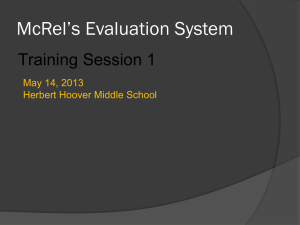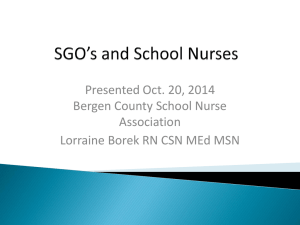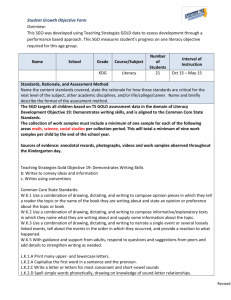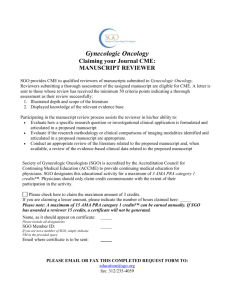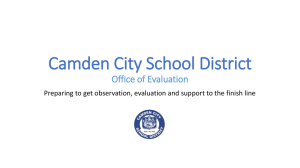Trenton SGO Workshop (PowerPoint
advertisement
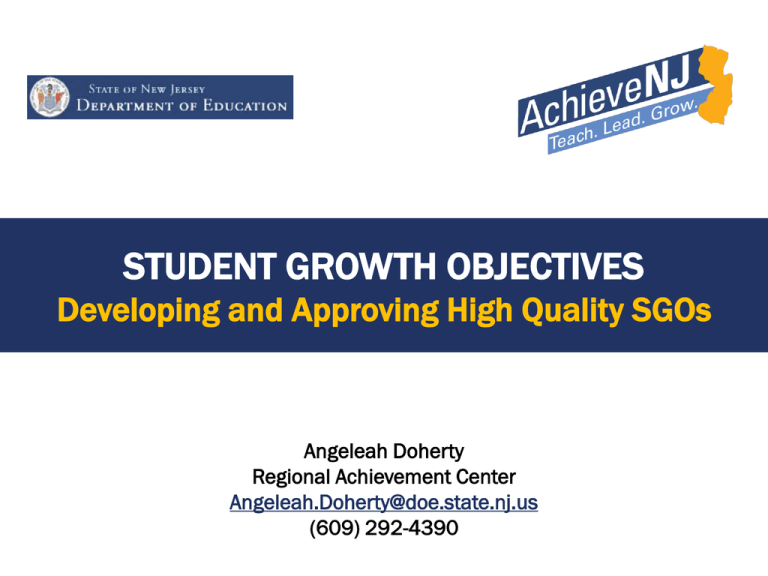
STUDENT GROWTH OBJECTIVES Developing and Approving High Quality SGOs Angeleah Doherty Regional Achievement Center Angeleah.Doherty@doe.state.nj.us (609) 292-4390 AGENDA • SGO General Requirements • SGO Process Components • Examples of SGOs/Analyze Components • How well do I understand SGOs? • Create an SGO w/Table • EXIT Ticket/Survey 2 Norms/To-DO 1. Sign-in Sheet 2. Maintain a positive attitude. 3. Be engaged in our work. 4. Questions-End 5. Remember the WHY: Student Achievement 3 SGO Materials • Agenda • SGO Frequently Asked Questions • SGO guidebook • How well do I know SGOs • SGO Examples • SGO Quality Rating Rubric • SGO Exit Ticket • Table Material 4 My Knowledge of SGOs… 5 What is an SGO? A Student Growth Objective is a long-term academic goal that teachers set for groups of students and must be: • Specific and measureable • Aligned to New Jersey’s curriculum standards • Based on available prior student learning data • A measure of student learning between two points in time SGO Guidebook pg. 3 6 What Constitutes “Growth” In Student Growth Objectives For the purposes of SGOs, the Department is defining “growth” as an increase in learning between two points in time, such as that indicated by: • Acquisition of knowledge or skill from a particular starting point or readiness level. • Development of a portfolio indicating a change in skill or knowledge over a period of time. • Difference in learning on pre- and post-tests. 7 What Do Effective Teachers Do? Teach a curriculum that is aligned to standards. Determine the needs of students using several methods including a variety of assessments. Differentiate instruction based on the needs of students. Set goals for students appropriate to their grade, subject, and readiness level. Use high quality assessments to measure student performance. Work in collaborative groups to improve student achievement. 8 What Do SGOs Require Teachers to Do? Teach a curriculum that is aligned to standards. Determine the needs of students using several methods including a variety of assessments. Differentiate instruction based on the needs of students. Set goals for students appropriate to their grade, subject, and readiness level. Use high quality assessments to measure student performance. Work in collaborative groups to improve student achievement. Formalize and document the process, and be recognized for doing these things well. 9 General and Targeted SGOs General • Captures a significant proportion of the students and key standards for a given course or subject area Targeted • Focuses on a particular subgroup of students, and/or specific content or skill 10 SGO – Simple Form 11 SGO - Tiered Form 12 Student Growth Percentiles • A teacher can only receive a median SGP score if the following is true: • Teacher has at least 20 students on the roster: • If teacher does not have 20 students in year 1, she may receive an SGP score if teacher accrues 20 students over a period of up to 3 years. • Students are enrolled in class at least 70% of the time before the test; and the teacher has worked for at least 60 percent of the time before the test. 13 SGOs in AchieveNJ - Requirements • All teachers who receive an SGP score must set 1 or 2 SGOs. • Teachers who do not receive an SGP score must set 2 SGOs. • A teacher develops SGOs in consultation with his or her principal. • SGOs must be aligned to NJCCCS or CCSS and measure student achievement and/or growth between two points in time. • SGOs must be specific and measurable and based on students’ prior learning data when available. • A teachers final SGO rating is determined by the principal. SGO Guidebook pg. 5 14 SGOs in AchieveNJ • SGOs must be submitted with final approval by November 15th. • Mid-Course Check-in by Feb. 15th. • SGOs are 10% of the Principals summative evaluation and 20% of the leadership rubric. SGO Guidebook pg. 5 15 SGOs and AchieveNJ 16 SGPs and SGOs SGP SGO • 4-8 grade ELA and math • All teachers • SGP score captures a significant portion of the curriculum and students for which the teacher is responsible • SGO score captures a significant portion of the curriculum and students for which the teacher is responsible 17 Developing SGOs to Meet the “Significant” Threshold Teacher SGOs Notes/Examples Non-tested Grades and Subjects 1 prep One general SGO for all students plus one targeted SGO (may be a targeted content/skill or group of students) General SGO includes 70% history standards and all students Targeted SGO focuses on use of informational text by all students 2 preps One general SGO for all students in each course Algebra 1 – SGO 1 Geometry – SGO 2 More than 2 preps One general SGO for all students in each Spanish 1 (56 students) –SGO 1 of the two courses containing the highest Spanish 2 (43 students) – SGO 2 numbers of students AP Spanish (8 students) – no SGO Elementary Two general SGOs for all students in two developmental domains or two subject areas Literacy domain – SGO 1 Language domain – SGO 2 Math – SGO 1 Science – SGO 2 Tested Grades and Subjects (receive an SGP score) All One or two SGOs (district discretion), general or targeted SGP provides one broad measure of student performance. Teachers and districts determine SGO makeup based on needs.18 Developing SGOs in Other Circumstances • Special Education teachers – Educators in inclusion class collaborate on a common SGO for all students – ICS teacher sets SGO for students with IEPs – Use IEP goals to help inform SGOs for particular students or groups of students – SGOs for non-academic growth may be used in exceptional circumstances • Small Student Populations – Use multiple assessment strategies for each student • Semester courses – Set 2 SGOs (one per semester) before Nov 15, adjust scoring plan in second semester by Feb 15 – Set 2 SGOs for first semester • Marking period courses – Set goals for several marking periods and aggregate into one SGO – Set one SGO per marking period 19 Make a plan to develop your SGOs… Make a Plan Individually or with colleagues Determine the instructional period Determine the standards to be taught Align the assessment to the standards 20 Resources Planning Guide Sample page Back Planning Guide for Choosing or Developing a Quality Assessment (PDF | Word) Assessments 21 Sample page Resources Standards Alignment and Coverage Form Back Standards Alignment and Coverage Check (PDF | Word) Assessments 22 SGO Student DATA/Pre-Assessment 23 Example SGO 24 SGO Example 25 SGO Example - Tiered 26 Student Growth Objective Preparedness Group Number of Students in (e.g. Low, Medium, High) Each Group (Total) Target Score on PostAssessment (%) Number of Students Required for “Full Attainment” 25-30 Low 36/65 70 Medium 21/65 80 15-18 High 8/65 90 6-7 Scoring Plan Preparedness Group Target Score on Final Assessment Low 70 Medium 80 High 90 SGO Guidebook pg. 19 Objective Attainment Level Based on Percent and Number of Students Achieving Target Score Exceptional Full Attainment Partial Insufficient Attainment (4) (3) Attainment (2) Attainment (1) ≥ 85% ≥70% ≥55% <55% 27 Set Growth Objectives Tiered SGO Scoring Guide Groups Target Objective Attainment Based on Percent of Students Score on Achieving Target Score Final Exceptional Full Partial Insufficient Assessment 4 3 2 1 Low 70% Medium 80% High 90% At least 90% At least 80% At least 70% Less than 70% 28 Set Growth Objectives SGO Scoring Guide Target Score Attainment Level in Meeting Student Growth Objective 80% or Higher on Final Assessment Exceptional 4 Full 3 Partial 2 Insufficient 1 Percent of Students Meeting Target Greater than 84% 70-84% 55-69% Less than 55% 29 Set Growth Objectives Scoring Rubric Attainment of Student Growth Objective Exceptional 4 Teacher has demonstrated an exceptional impact on learning by exceeding the objective. Full 3 Teacher has demonstrated a considerable impact on learning by meeting the objective. Partial 2 Teacher has demonstrated some impact on learning but did not meet the objective. Insufficient 1 Teacher has demonstrated an insufficient impact on learning by falling far short of the objective. 30 Kindergarten SGOs Example 1: A kindergarten teacher has 14 students and uses a locallydeveloped portfolio to assess her students. She sets one of her SGOs for all of her students based on their growth in 70% of literacy standards. She sets her second SGO based on their growth in 60% of math standards. Example 2: A kindergarten teacher has 8 students and uses the DRA2 to assess her students. She sets one of her SGOs to include the standards incorporated by the DRA2. She sets a second SGO towards CCSS.Math.Content.K.CC.A.1 Count to 100 by ones and by tens. 31 Elementary Science SGO Example 3: A 4th-grade elementary team develops an SGO for science. In consultation with the middle school science teacher, the team develops a portfolio assessment that requires the students to demonstrate the critical standards-based skill of scientific thinking and practice. Each teacher sets an SGO scoring plan for her individual class based on the starting point of her students. Students build a science portfolio throughout the year. At the end of the year, the team sits together to collaboratively grade the portfolios using a rubric. 32 Choose or Develop a Quality Assessment 3 components 1. Assessment Scope What do you want your students to know and be able to do? 2. Assessment Quality Is your assessment a fair and accurate measure of student performance? 3. Collection of Evidence Is the scoring and administration of school-based assessments reliable and fair? 33 Assessment Quality Types of Assessments Traditional Assessments • • • • • District, school and departmental tests e.g., modified final exams, benchmark exams State and national exams (except the NJ ASK), e.g. NOCTI, AP Portfolio Assessments • • • • • Writing and reflection sample Laboratory research notebook Portfolio of work Project-based assessment Teaching Strategies Gold® Performance Assessment • • • • • • Lab practicum Sight reading in music Dramatic performance Skills demonstration Persuasive speaking DRA™2 Purchase a new assessment or select an existing one Create a new assessment locally Modify an existing assessment SGO Guidebook pg.10 34 District Guidelines – Teacher Evaluation Packet Page 150/Non-Tested Areas Raw Score FINAL 85% TEACHER PERFORMANCE 15% STUDENT ACHIEVEMENT MUTUALLY AGREED SGOD 85% TEACHER EVALUATION 7.5% SGO 1 SMI/SRI/IRLA/DRA PORTFOLIO ASSESSMENT PERFORMANCE TASK PRE-POST TESTS FINAL EXAM 7.5% SGO 2 SMI/SRI/IRLA/DRA PORTFOLIO ASSESSMENT PERFORMANCE TASK PRE-POST TESTS FINAL EXAM Weight Weighted Score X 55% X 30% X15% 35 District Guidelines – Teacher Evaluation Packet Page 146/Tested Areas Raw Score FINAL 55% TEACHER PERFORMANCE 45% STUDENT ACHIEVEMENT SGP MUTUALLY AGREED SGO 55% TEACHER EVALUATION 30% STATE TEST or PERFORMANCE TASK 15% SGO SMI/SRI/IRLA/DRA PORTFOLIO ASSESSMENT PERFORMANCE TASK PRE-POST TESTS FINAL EXAM Weight Weighted Score X 55% X 30% X15% TOTAL SCORE 36 Determine Students’ Starting Points Examples Source of Performance Data to Determine Students’ Starting Points Grades/performance in current year Based on all aspects of work during the first few weeks of school Beginning-of-course diagnostic tests or performance tasks Department-generated pre-assessment Early course test Prior-year test results that assess knowledge and skills that are prerequisites to the current subject/grade NJASK for math, LAL and science DRA for reading End of course assessments Test results in other relevant subjects from prior years A physics teacher uses results of her students’ math tests from last year Students’ grades in previous classes Teachers should make sure they understand the basis for the grades given by students’ previous teachers Examples and Notes 37 Using Multiple Measures to Determine Student Growth Potential Student ID Prior Test Scores Current Year Test Scores Markers of Future Success Preparedness Group NJ ASK 8 Math Unit 1 Unit 2 Average Score Class participation Takes retakes Completes homework Total Points 1 230 100 97 98.5 Yes Yes No 2 High 2 202 90 95 92.5 Yes Yes Yes 3 High 3 211 95 95 95 Yes Yes Yes 3 High 4 241 85 86 85.5 Yes No No 1 High 5 263 90 92 91 Yes No Yes 2 High 6 284 90 85 87.5 Yes No Yes 2 High 7 199 91 88 89.5 Yes Yes Yes 3 High 8 201 57 75 66 No Yes No 1 Low 9 144 50 58 54 No No No 0 Low 10 182 58 58 58 No No No 0 Low 11 143 62 83 72.5 Yes Yes No 2 Medium 12 171 78 83 80.5 No Yes No 1 Medium NJ ASK Math Score <200 200 – 249 200 – 300 Current Year Test Score Average <70 70 – 85 85 – 100 Number of Future Success Markers 0–1 1–2 2–3 Preparedness Group Low Medium High Target Score on Summative 70 80 90 38 Collection of Evidence Administration and Scoring of Assessments What are the most valid, reliable, and practical ways to administer and score school-based assessments in your district? Will assessments be administered in one sitting or several? Should the students’ teacher be the one administering the assessment? Who should score the assessments? Would professional development in scoring or other aspects of assessment be useful in your district? 39 Reviewing the SGOs What is the most efficient process to develop and review SGOs? Questions to answer… Will SGOs be developed during common planning? Who is going to decide the exact assessments to use? Who is going to review the baseline data for the SGOs? Who are SGOs being submitted to (School/District)? How many SGOs are teachers going to write if they are supposed to receive an SGP? What forms will teachers use during the SGO process? 40 Look-fors 1. Does the SGO include a significant proportion of students and curriculum? 2. Does the assessment fairly and accurately measure the standards being taught? 3. Are starting points determined using appropriate measures that enable good learning targets to be set for students? 4. Does the scoring plan reflect ambitious and achievable goals for the teacher based on the student data and the rigor and scope of the assessment? 41 QUESTIONS???? 42 Your Next Steps • Begin to develop an SGO? With your table, create an SGO. • You have at your table: • Blank Data Document, Assessment/Standard Alignment document, An SGO form (tiered) • If you know the standards, list them. • Examples: DRA, SMI 43 Your Next Steps • Look over the material in your folder. Be able to answer the questions on “How well do I know SGOs?” • Begin to develop an SGO? With your table, create an SGO. • You have at your table: • Blank Data Document, Assessment/Standard Alignment document, An SGO form (tiered) • If you know the standards, list them. • Examples: DRA, SMI 44 Resources at the NJDOE • AchieveNJ website • SGO Training modules/guidebook/exemplars • FAQs • Angeleah.doherty@doe.state.nj.us 45
